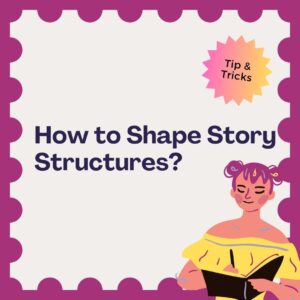Shaping Story Structures: A Ultimate Guide for Writers
Story structure is the backbone of any narrative, providing a framework that guides the development of characters, plot, and themes. Understanding how to shape story structures effectively can significantly enhance your writing and engage your readers. This comprehensive guide will explore various story structures, their components, and practical tips for crafting compelling narratives.

Table of Contents
What is Story Structure?
Story structure refers to the organized framework that outlines how a narrative unfolds over time. It encompasses the sequence of events, character development, and thematic elements that work together to create a coherent and engaging story.
Key Features of Story Structure:
- Framework: Provides a guideline for organizing plot points and character arcs.
- Flow: Ensures that the story progresses logically and maintains reader interest.
- Engagement: Helps create tension and emotional investment in the narrative.
The Importance of Story Structure
Understanding story structure is crucial for several reasons:
- Guides Writing: A clear structure helps writers stay focused and organized throughout the writing process.
- Enhances Pacing: Properly structured stories maintain a rhythm that keeps readers engaged.
- Facilitates Character Development: A solid structure allows for meaningful character growth and transformation.
- Establishes Themes: A well-defined structure helps convey underlying messages effectively.
Common Story Structures
Several established story structures can serve as templates for writers:
The Three-Act Structure
The Three-Act Structure is one of the most widely used frameworks in storytelling, dividing a narrative into three main parts:
- Act One (Setup):
- Introduces characters, setting, and initial conflict.
- Ends with an inciting incident that propels the protagonist into action.
- Act Two (Confrontation):
- Develops rising action as characters face challenges.
- Includes subplots that enrich the main storyline.
- Act Three (Resolution):
- Brings the climax to a head, resolving conflicts.
- Concludes with falling action and resolution.
Example:
In The Hunger Games by Suzanne Collins:
- Act One introduces Katniss Everdeen and her world.
- Act Two depicts her struggles in the arena.
- Act Three resolves her conflict with the Capitol.
The Five-Act Structure
The Five-Act Structure expands on the Three-Act model by adding more detail:
- Exposition: Introduces characters and setting.
- Rising Action: Builds tension through complications.
- Climax: The turning point where conflict reaches its peak.
- Falling Action: Consequences of the climax unfold.
- Denouement: Final resolution where loose ends are tied up.
Example:
Shakespeare’s plays often follow this structure, with clear divisions between acts that enhance dramatic tension.
The Hero’s Journey
Joseph Campbell’s concept of the Hero’s Journey outlines a common narrative arc found in many myths and stories:
- Ordinary World: Introduces the hero in their normal life.
- Call to Adventure: The hero faces a challenge or quest.
- Refusal of the Call: Initial hesitation or fear about embarking on the journey.
- Meeting the Mentor: Guidance from a mentor figure.
- Crossing the Threshold: Leaving the ordinary world behind.
- Tests, Allies, Enemies: Facing challenges along the way.
- Approach to the Inmost Cave: Preparing for a major conflict.
- Ordeal: Facing a critical challenge or enemy.
- Reward: Gaining something valuable after overcoming obstacles.
- The Road Back: Returning to the ordinary world with newfound knowledge or power.
- Resurrection: Final test where everything is at stake.
- Return with Elixir: Bringing back lessons learned to improve life.
Example:
In The Lord of the Rings, Frodo Baggins embarks on a journey from his peaceful home to destroy the One Ring, encountering numerous trials along the way.
The Snowflake Method
Developed by Randy Ingermanson, this method emphasizes starting with a simple idea and expanding it into a full-fledged story through structured steps:
- Write a one-sentence summary of your story.
- Expand it into a paragraph describing major plot points.
- Create character profiles for main characters.
- Write a one-page synopsis for each character’s arc.
- Expand each paragraph into scenes.
Example:
This method helps writers build complexity gradually while ensuring all elements are interconnected.
The Seven-Point Structure
This structure breaks down storytelling into seven key components:
- Hook: Grabs attention at the beginning.
- Set-Up: Introduces characters and setting.
- Catalyst: The inciting incident that starts the action.
- Debate: Characters grapple with their choices before committing to action.
- Break into Two: Transition from setup to confrontation phase.
- Confrontation: Main character faces challenges leading up to climax.
- Resolution: Concludes with resolution of conflicts.
Elements of Story Structure
Understanding key elements within any story structure will help you craft compelling narratives:
Exposition
This is where you introduce your characters, setting, and primary conflict—essentially laying the groundwork for your story.
Example:
In Harry Potter and the Sorcerer’s Stone, J.K Rowling introduces Harry’s mundane life with the Dursleys before revealing his magical heritage.
Rising Action
This phase involves building tension through complications that challenge your protagonist.
Example:
In The Fault in Our Stars, Hazel faces increasing challenges as her relationship with Augustus deepens amid their health struggles.
Climax
The climax represents the turning point where tensions reach their highest point; it’s often where everything changes for your protagonist.
Example:
In Romeo and Juliet, when Romeo kills Tybalt, it sets off a chain reaction leading to tragic consequences.
Falling Action
Following the climax, falling action addresses how characters deal with its aftermath; it leads toward resolution.
Example:
After Tybalt’s death, Romeo’s banishment creates tension as Juliet grapples with her love for him versus her loyalty to her family.
Resolution
The resolution ties up loose ends, providing closure to conflicts introduced earlier in your story.
Example:
In Pride and Prejudice, Elizabeth Bennet’s acceptance of Darcy resolves their misunderstandings and concludes their romantic journey.
Character Arcs and Their Role in Story Structure
Character arcs are essential components that work alongside plot structure:
Understanding Character Arcs:
- A character arc represents how a character evolves throughout a story based on experiences faced during their journey.
Types of Character Arcs:
- Positive Arc: Characters grow positively through challenges (e.g., learning lessons).
- Negative Arc: Characters decline or regress due to choices made (e.g., tragic heroes).
- Flat Arc: Characters remain largely unchanged but influence others around them (e.g., mentors).
Using Conflict to Shape Your Story
Conflict is at the heart of every compelling narrative; it drives character development and plot progression:
Types of Conflict:
- Internal Conflict: Struggles within a character (e.g., moral dilemmas).
- External Conflict: Challenges posed by outside forces (e.g., antagonists or societal pressures).
Understanding how conflicts interact within your chosen structure will enhance storytelling effectiveness.
Creating Subplots Within Your Structure
Subplots can add depth to your main narrative by introducing secondary conflicts or themes:
Tips for Integrating Subplots:
- Ensure subplots are relevant to main themes or character arcs.
- Balance subplot development with primary plot progression; avoid overshadowing main events.
How to Choose the Right Structure for Your Story
Selecting an appropriate structure depends on various factors:
- Identify your genre (e.g., thriller vs romance) as it may dictate structural norms.
- Consider your audience; different demographics may respond better to certain structures (e.g., young adult vs literary fiction).
- Reflect on your story’s core question or theme; let this guide your structural choice.
Common Mistakes to Avoid in Story Structure
When shaping your story structure, be aware of these common pitfalls:
- Lack of Conflict: Ensure there are sufficient challenges driving your plot forward; without conflict, stories can feel flat or unengaging.
- Inconsistent Pacing: Maintain balance throughout different sections; avoid dragging out scenes unnecessarily or rushing through critical moments without adequate buildup.
- Neglecting Character Development: Ensure characters evolve alongside plot progression; static characters can detract from overall engagement.
Conclusion
Understanding story structure is essential for writers seeking to create compelling narratives that resonate with readers emotionally while maintaining clarity throughout their storytelling process! By exploring various structures—such as three-act frameworks, character arcs, conflicts—and honing skills through practice—you’ll be well-equipped to craft engaging stories that captivate audiences from beginning to end!




